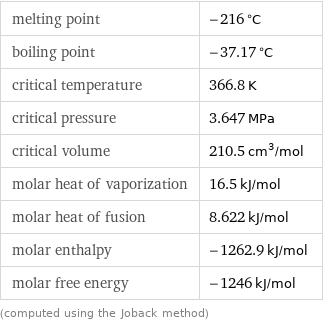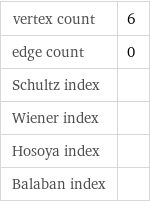Input interpretation

pentafluoride chlorine
Basic properties
![molar mass | 130.4 g/mol formula | ClF_5 empirical formula | Cl_F_5 SMILES identifier | [Cl+5].[F-].[F-].[F-].[F-].[F-] InChI identifier | InChI=1/Cl.5FH/h;5*1H/q+5;;;;;/p-5/fCl.5F/h;5*1h/qm;5*-1 InChI key | FWNAIVPWDILXEF-UHFFFAOYSA-I](../image_source/6e20bafdb5cb990cb70900396fede174.png)
molar mass | 130.4 g/mol formula | ClF_5 empirical formula | Cl_F_5 SMILES identifier | [Cl+5].[F-].[F-].[F-].[F-].[F-] InChI identifier | InChI=1/Cl.5FH/h;5*1H/q+5;;;;;/p-5/fCl.5F/h;5*1h/qm;5*-1 InChI key | FWNAIVPWDILXEF-UHFFFAOYSA-I
Structure diagram

Structure diagram
Estimated thermodynamic properties

melting point | -216 °C boiling point | -37.17 °C critical temperature | 366.8 K critical pressure | 3.647 MPa critical volume | 210.5 cm^3/mol molar heat of vaporization | 16.5 kJ/mol molar heat of fusion | 8.622 kJ/mol molar enthalpy | -1262.9 kJ/mol molar free energy | -1246 kJ/mol (computed using the Joback method)
Units

Quantitative molecular descriptors

longest chain length | 0 atoms longest straight chain length | 0 atoms longest aliphatic chain length | 0 atoms aromatic atom count | 0 atoms H-bond acceptor count | 0 atoms H-bond donor count | 0 atoms
Elemental composition

Find the elemental composition for pentafluoride chlorine in terms of the atom and mass percents: atom percent = N_i/N_atoms × 100% mass percent = (N_im_i)/m × 100% Plan: • Write the chemical formula and gather atomic masses from the periodic table. • Determine values for N_i, m_i, N_atoms and m using these items. • Finally, compute the percents and check the results. Write the chemical formula: ClF_5 Use the chemical formula to count the number of atoms, N_i, for each element and find the total number of atoms, N_atoms, per molecule: | number of atoms Cl (chlorine) | 1 F (fluorine) | 5 N_atoms = 1 + 5 = 6 Divide each N_i by N_atoms to calculate atom fractions. Then use the property that atom fractions must sum to one to check the work: | number of atoms | atom fraction Cl (chlorine) | 1 | 1/6 F (fluorine) | 5 | 5/6 Check: 1/6 + 5/6 = 1 Compute atom percents using the atom fractions: | number of atoms | atom percent Cl (chlorine) | 1 | 1/6 × 100% = 16.7% F (fluorine) | 5 | 5/6 × 100% = 83.3% Look up the atomic mass, m_i, in unified atomic mass units, u, for each element in the periodic table: | number of atoms | atom percent | atomic mass/u Cl (chlorine) | 1 | 16.7% | 35.45 F (fluorine) | 5 | 83.3% | 18.998403163 Multiply N_i by m_i to compute the mass for each element. Then sum those values to compute the molecular mass, m: | number of atoms | atom percent | atomic mass/u | mass/u Cl (chlorine) | 1 | 16.7% | 35.45 | 1 × 35.45 = 35.45 F (fluorine) | 5 | 83.3% | 18.998403163 | 5 × 18.998403163 = 94.992015815 m = 35.45 u + 94.992015815 u = 130.442015815 u Divide the mass for each element by m to calculate mass fractions. Then use the property that mass fractions must sum to one to check the work: | number of atoms | atom percent | mass fraction Cl (chlorine) | 1 | 16.7% | 35.45/130.442015815 F (fluorine) | 5 | 83.3% | 94.992015815/130.442015815 Check: 35.45/130.442015815 + 94.992015815/130.442015815 = 1 Compute mass percents using the mass fractions: Answer: | | | number of atoms | atom percent | mass percent Cl (chlorine) | 1 | 16.7% | 35.45/130.442015815 × 100% = 27.18% F (fluorine) | 5 | 83.3% | 94.992015815/130.442015815 × 100% = 72.82%
Elemental oxidation states

The first step in finding the oxidation states (or oxidation numbers) in pentafluoride chlorine is to draw the structure diagram. Next set every oxidation number equal to the atom's formal charge: Now summarize the results: Answer: | | oxidation state | element | count -1 | F (fluorine) | 5 +5 | Cl (chlorine) | 1
Topological indices

vertex count | 6 edge count | 0 Schultz index | Wiener index | Hosoya index | Balaban index |